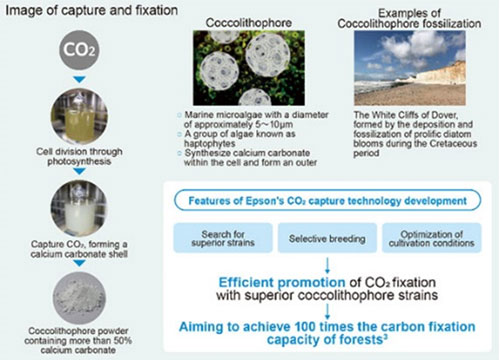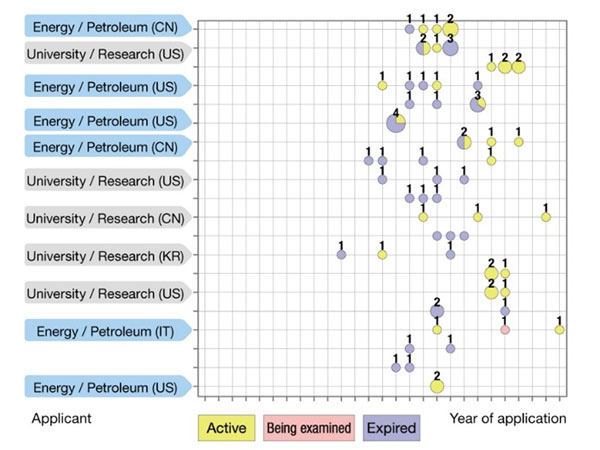Research and Analysis
Epson's Intellectual Property Research
IP Landscape Contributes to Policymaking
In general terms, "IP landscape" is defined as (1) "conducting analysis that incorporates IP information into management and business information and (2) sharing the results (including a broad view of the current situation and future prospects) with management and administrative officers, when formulating management or business strategies"(Quoted from the Japan Patent Office "Survey Research Report on Analysis and Utilization of Intellectual Property Information that Contributes to Management Strategies"https://www.jpo.go.jp/support/general/chizai-jobobunseki-report.html)
In Epson's IP landscaping, what matters most is to help shape policy for management, business, development, and intellectual property. No matter how excellent the analysis, it is meaningless if the results do not contribute to policy decisions. It is essential to not only provide information based on analysis but also connect it to some form of decision-making.
To achieve this, both the content of the analysis and the timeliness of the information and proposals provided are of great importance. From day to day, we focus on quickly completing research and analysis and furnishing proposals as well as on staying ahead of others with research and analysis.

An example of an IP landscape that Epson implemented to support new innovations is provided below.
Epson placed a strong emphasis on the environment, co-creation, and digital transformation in its "Epson 25 Renewed" corporate vision. Among the innovative environmental initiatives, we are pursuing is the development of CO2 capture technology using microalgae. We have focused on coccolithophores for CO2 separation and fixation. By optimizing culture conditions and utilizing various breeding techniques, we have so far succeeded in increasing the amount of CO2 fixed in the lab to 70 times that of forests1 and are looking to further increases in fixation.
1 Calculation is based on the data from the Forestry and Forest Products Research Institute (FFPRI), Japan

At the investigative stage of development, we had not yet decided what type of algae to use, nor had we fully grasped the development trends of others, including the status of acquisition of intellectual property rights. So, to quickly research and decide on the direction of development, we analyzed intellectual property information using an IP landscape. By conducting the IP landscape analysis, we were able to uncover various situations.
The first step is to analyze the status of intellectual property rights obtained by others. As shown in the chart below, we found that were not many patent applications, and that there were few applicants who could potentially compete with our business, indicating that the barriers to entry were low. On the other hand, the timing and number of applications filed by the preceding companies and universities gave us insight into the developmental organization and co-creation relationship at the start of development. By analyzing intellectual property information in this way, we were able to identify the optimal development framework and co-creation partners, which accelerated the development of CO2 capture technology.

The second step is to analyze issues related to CO2 capture. When patent applications related to CO2 capture were mapped and analyzed based on the technical issues that the inventions solve, a picture emerged of the technical issues that needed to be addressed for efficient CO2 capture. One of these issues was of great interest to the development department. A more detailed analysis of the applications related to this technical issue revealed an effective approach to a solution. The proposal based on this information was useful to the development department and contributed to the consideration of the development direction.

This is an example of how we have supported innovation by conducting an analysis, providing information, and making proposals based on an IP landscape in the initial stages of considering new development themes.
Epson's Intellectual Property Division has established a team that specializes in strategic research and analysis of IP landscapes to contribute to policy decisions. We will continue to support innovation by making proposals for various themes based on the analysis of IP landscapes.
FTO Analyses to Minimize Business Risk
Epson is extremely careful not to infringe on the intellectual property rights of others. We want customers to enjoy new products and services that provide the value arising from our proprietary core technologies. However, if we were to infringe on another party's intellectual property rights to do so, we could end up not being able to use that technology and provide that value. Therefore, we expend considerable effort on freedom-to-operate (FTO) searches to prevent infringing on the intellectual property rights of others.
FTO searches find all third-party intellectual property related to new products and technology from among the vast sea of patents, both domestic and foreign. These are scrutinized to ensure that there is no infringement. Epson has a searcher team of experienced engineers with development and design backgrounds, a deep understanding of the technologies in our products and services. They use the latest databases to perform accurate FTO searches on hundreds of themes a year in a short period of time. Additionally, many of the searchers have experience in patent application and rights acquisition work. Leveraging this experience, if there are concerns about others' intellectual property, they contribute to maintaining activities that do not infringe on others' intellectual property rights by participating in the final review of non-infringement judgments, design avoidance considerations, and validity assessments in the development and design departments.


